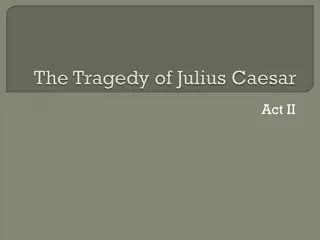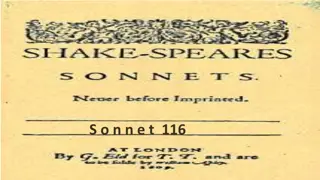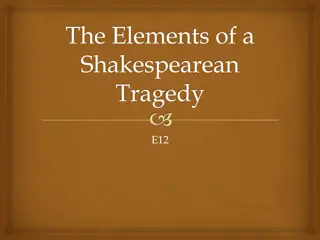Understanding Shakespearean Soliloquies: Language and Analysis
Explore the world of Shakespearean soliloquies through a comprehensive look at language, structure, and meaning. Dive into the nuances of Shakespearean vocabulary, grammar, and syntax to interpret and analyze the essence of soliloquies. Unravel the beauty of blank verse and learn essential tricks for reading Shakespeare to enhance your comprehension and appreciation of his works.
Download Presentation

Please find below an Image/Link to download the presentation.
The content on the website is provided AS IS for your information and personal use only. It may not be sold, licensed, or shared on other websites without obtaining consent from the author. Download presentation by click this link. If you encounter any issues during the download, it is possible that the publisher has removed the file from their server.
E N D
Presentation Transcript
Soliloquy RL.1 Cite Textual evidence RL.2 Determine a central idea RL.4 Determine meaning of words and phrases RL.5 Analyze how a soliloquy's form or structure contributes to its meaning SL.1 Engage in collaborative discussions. SL.6 Adapt speech to a variety of contexts and tasks
Objective Rationale Today we will be able to identify elements of Shakespearean language, interpret meaning, and analyze a soliloquy We need to be able to interpret Shakespearean vocabulary, grammar, sentence structure, and allusions.
Soliloquy A speech given by a character alone on a stage as if voicing his or her thoughts
Monologue A speech directed to an audience or other characters
The Language of Shakespeare Shakespeare's English Thou Thee Thy Thine Modern English You Yourself Your Yours Mine eyes My eyes
Syntax word order/Vocabulary Modern English I have made the strong- based promontory shake and plucked up the pine and cedar by the spurs Shakespeare s English The strong-based promontory have I made shake and by the spurs plucked up The pine and cedar I ve shaken up the sturdy cliffs and uprooted pines and cedars
Blank Verse In blank verse the final lines of the line do not rhyme and each line consist of 10 syllables with alternating stressed and unstressed (iambic pentameter) Mercutio's Queen Mab Monologue in Romeo and Juliet O, then, I see Queen Mab hath been with you. She is the fairies' midwife, and she comes In shape no bigger than an agate-stone On the fore-finger of an alderman, Drawn with a team of little atomies Athwart men's noses as they lie asleep;
Tricks to reading Shakespeare Understand the context of what you are reading. What has happened? Who is speaking? What is the subject? What is the verb? Remember, Shakespeare didn t follow the grammar rules you and I have to follow. Pay attention to Shakespeare s punctuation If a pronoun is used, what is the antecedent? Always read the footnotes that explain the allusions. (Allusions are very important to Shakespeare, they will always give valuable insight.) Look up any words you don t know. Paraphrase what you read a couple of lines at a time.
Shakespeares Punctuation Period full stop with extra emphasis; the sentence and thought comes to a complete halt Comma indicates a shift in thought, but also a place to take a breath Colon an indication of a new thought arising; the character is taking a new direction with their intention Semicolon an indication that the next line will be an explanation of the thought that precedes the semicolon
Collections Page 145 Excerpt from The Tempest Act 5, Scene 1























